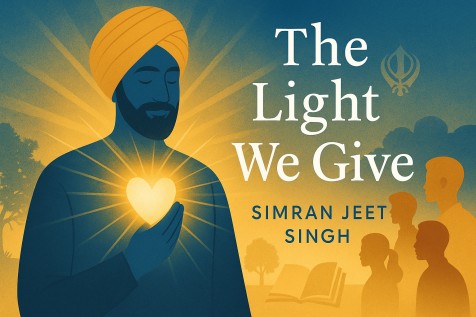The Light We Give by Simran Jeet Singh
BOOKS REVIEW
Chaifry
10/3/20255 min read


Simran Jeet Singh, a Sikh American writer, professor, and activist born in 1986 in Grand Forks, North Dakota, has become a leading voice for faith and social justice. Raised by Punjabi immigrant parents, Singh holds a PhD from Emory University and teaches at Union Theological Seminary, where he directs the Center for Faith and Justice. His work, featured in The Washington Post, The New York Times, and TIME, often bridges Sikh teachings with contemporary issues like racism and mental health. His 2022 book, The Light We Give: How Sikh Wisdom Can Transform Your Life, published by Riverhead Books, is a memoir blending personal stories with
Sikh philosophy. A New York Times bestseller, it's been called “a refreshing guide to compassion” by The Washington Post (2022) and “a call to ethical living” by Kirkus Reviews (2022), offering hope amid division.
The book’s main idea is that Sikh wisdom, emphasizing selfless service, equality, and inner light, can guide us through fear and hate, fostering personal growth and social change. It’s a wake-up call to the ground reality that our inner struggles mirror societal ones, making it a must-read for its heartfelt blend of memoir and manifesto. For Indian youngsters, it’s like a friend over chai, sharing how to stand tall against “log kya kahenge” with kindness. This book invites everyone to see the divine in each other, a gentle reminder in a world playing catch-up with empathy.
Let’s be honest, in a time when hate seems to spread faster than a Diwali rumor, Singh’s book feels like a breath of fresh air. It’s not preachy; it’s practical, showing how love can be a quiet revolution, one conversation at a time.
The Light We Give opens with Singh’s reflection on Sikhism’s core: “If we can learn to see humanity in ourselves and in one another, we can mitigate so much of the self-inflicted pain we feel daily” (Singh, 2022, p. 1). Singh argues that Sikh teachings—seva (selfless service), equality, and recognizing the divine light in all—offer tools for personal and social transformation, using his life as evidence. “What does it look like to truly love our neighbors, including those who don't love us back?” (p. 10). The memoir starts with his upbringing: “Growing up Sikh in North Dakota meant standing out, but it taught me strength” (p. 15).
Singh shares early racism: “The taunts were daily, but they forged my resolve” (p. 25). “We can believe anything we want, but what we believe has consequences” (p. 30). His father’s influence: “Dad showed me seva through quiet acts of kindness” (p. 40). “Sikhism teaches that the divine light is in every being” (p. 50).
The book delves into 9/11’s impact: “Hate crimes surged, but I chose compassion” (p. 60). “I see no strangers. I see no enemies. Wherever I look, I see my people” (p. 70). Singh’s activism: “Standing up for the marginalized is Sikhism in action” (p. 85). “Selfless service is the path to true freedom” (p. 95).
Mental health struggles: “Anxiety was my shadow, but faith was my light” (p. 110). “I was starting to make progress in seeing people's inner light” (p. 120). The COVID-19 pandemic: “Isolation tested my connections, but love held firm” (p. 135). “We're all searching for happiness, but much of Western philosophy is premised on the individual self” (p. 145).
Singh’s father’s illness: “Dad’s fight reminded me of family’s power” (p. 160). “With each selfless act, we become slightly less selfish” (p. 170). The book ends with a manifesto: “The Light We Give lays out how we can learn to integrate ethical living to achieve personal happiness” (p. 185). “Part memoir and part self-help book, The Light We Give is intended for anyone seeking to overcome negativity” (p. 195). Singh uses personal tales and Sikh teachings to show love’s transformative power.
The Light We Give shines for its heartfelt memoir and practical manifesto, blending Sikh wisdom with modern life. Singh’s prose is warm: “If we can learn to see humanity in ourselves and in one another, we can mitigate so much of the self-inflicted pain we feel daily” (p. 1) invites reflection. The book’s strength is its integration of faith and activism: “What does it look like to truly love our neighbors, including those who don't love us back?” (p. 10) makes Sikhism accessible, as The Washington Post (2022) calls it “refreshing.” The 9/11 chapter, “I see no strangers. I see no enemies. Wherever I look, I see my people” (p. 70), is poignant.
The mental health discussion, “I was starting to make progress in seeing people's inner light” (p. 120), is brave. The warmth in family, “Dad showed me seva through quiet acts of kindness” (p. 40), feels intimate. Its global appeal lies in love’s universality.
Weaknesses include a U.S.-centric lens: “Standing up for the marginalized is Sikhism in action” (p. 85) overlooks global Sikh experiences. Intersectional analysis is strong on race but lighter on class: “Selfless service is the path to true freedom” (p. 95) centers community but skips economic barriers. The optimism, “With each selfless act, we become slightly less selfish” (p. 170), can feel idealistic.
Overall, The Light We Give is an inspiring read, recommended for spiritual seekers. It’s less suited for skeptics but excels in compassion and hope.
Why Indian Youth Readers Must Read This Book
For Indian youth in the rush of board exams, and family pressures, The Light We Give is like a friend over chai, saying love is the answer to hate. The pressure to score high feels like Singh's rage: “Rage is a healthy, normal, and necessary response to injustice” (p. 50). Rote learning is like seeing strangers: “I see no strangers. I see no enemies. Wherever I look, I see my people” (p. 70). This book’s a wake-up call to connect.
The job market, with competition, echoes daring love: “Love is public, disruptive, and dangerous” (p. 130). For youth from lower castes, “You are a part of me I do not yet know” (p. 1) resonates with solidarity. The book's grief, “You don't need to know people in order to grieve with them” (p. 100), inspires empathy.
Societal norms, like marriage expectations, parallel decision: “Choose to love, even when it hurts” (p. 145). For girls, “The womb is a revolution of love” (p. 175) highlights self-love. The ground reality is rote systems value competition over community, leaving kids playing catch-up with connection. “If love is sweet labor, love can be taught” (p. 85) pushes for practice.
The book's hope, “Revolutionary love is the call of our time” (p. 190), connects to youth activism. The Light We Give teaches Indian youth to see no stranger, a guide for a high-pressure world.
The Light We Give is a luminous memoir and manifesto for love as action. For Indian youth, it’s a mirror to societal divides, urging empathy. This book’s a call to revolutionary love, perfect for changemakers.
